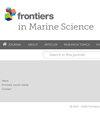热带和南大西洋关键地区卫星衍生叶绿素-a年际变化的物理驱动因素和重建
IF 3
2区 生物学
Q1 MARINE & FRESHWATER BIOLOGY
引用次数: 0
摘要
了解海洋初级生产力变异的驱动因素对于增进我们对海洋生态系统和生物地球化学循环功能的理解至关重要。本文分析了热带和南大西洋6个沿海地区卫星衍生叶绿素-a (CHL)的年际变化及其潜在的海洋过程。在南美海岸,海面高度(SSH)和沿岸速度(代表地表流动)被确定为主要驱动因素。在非洲海岸,与沿海上升流有关的海表温度和海面高度变化是主要的驱动因素。发现了与热带南大西洋、偶极模式指数、西半球暖池和南方涛动指数的重要联系,表明遥相关在chl变率中的潜在作用。利用多元线性回归和神经网络模型重建区域CHL序列。多元线性模型能够重现观测到的CHL方差的显著部分。特别是,基于海表温度经验正交函数分解的特征值的模型优于其他模型。神经网络模型再现了大部分CHL方差的最高性能(> 70%),但难以推断单个驱动因素的相对重要性。在此拟合/训练期之后,多元线性模型的效果优于神经网络模型,特别是基于海洋变量的神经网络模型。这些CHL重建模式提供了在没有观测到CHL的时期重现CHL的可能性,甚至可以在多年气候预估中预测CHL。本文章由计算机程序翻译,如有差异,请以英文原文为准。
Physical drivers and reconstruction of the interannual variability of satellite-derived chlorophyll-a in key regions of the tropical and south Atlantic
Understanding drivers of variability in oceanic primary productivity is essential to increase our understanding of the functioning of marine ecosystems and biogeochemical cycles. Here, interannual variability of satellite-derived chlorophyll-a (CHL) and its underlying oceanographic processes are analyzed in six coastal regions of the tropical and south Atlantic. Along the South American coast, sea-surface height (SSH) and alongshore velocity, proxies for surface flows, were identified as the main drivers. Along the African coast, variations in sea-surface temperature (SST) and SSH related to coastal upwelling, were the dominant drivers. Important links to the Tropical Southern Atlantic, Dipole Mode Index, Western Hemisphere Warm Pool, and Southern Oscillation Index indices were identified, indicating potential role of teleconnections in the CHL-variability. The identified driver-linked variables were used to reconstruct the regional CHL series using multi-linear regressions and a neural-network model. The multi-linear models were able to reproduce significant fractions of the observed CHL variance. In particular, a model based on eigenvalues from an empirical orthogonal function decomposition of SST, outperformed the others. The neural-network model shows the highest performance reproducing most of the CHL variance (> 70%), but it presents difficulty to deduce the relative importance of individual drivers. Beyond this fitting/training period, the multi-linear model show better results respect to the neural-network model, especially that based on oceanographic variables. These CHL-reconstruction models present the possibility to reproduce CHL in periods when its observation is unavailable and even to predict it in multi-year climate projections.
求助全文
通过发布文献求助,成功后即可免费获取论文全文。
去求助
来源期刊

Frontiers in Marine Science
Agricultural and Biological Sciences-Aquatic Science
CiteScore
5.10
自引率
16.20%
发文量
2443
审稿时长
14 weeks
期刊介绍:
Frontiers in Marine Science publishes rigorously peer-reviewed research that advances our understanding of all aspects of the environment, biology, ecosystem functioning and human interactions with the oceans. Field Chief Editor Carlos M. Duarte at King Abdullah University of Science and Technology Thuwal is supported by an outstanding Editorial Board of international researchers. This multidisciplinary open-access journal is at the forefront of disseminating and communicating scientific knowledge and impactful discoveries to researchers, academics, policy makers and the public worldwide.
With the human population predicted to reach 9 billion people by 2050, it is clear that traditional land resources will not suffice to meet the demand for food or energy, required to support high-quality livelihoods. As a result, the oceans are emerging as a source of untapped assets, with new innovative industries, such as aquaculture, marine biotechnology, marine energy and deep-sea mining growing rapidly under a new era characterized by rapid growth of a blue, ocean-based economy. The sustainability of the blue economy is closely dependent on our knowledge about how to mitigate the impacts of the multiple pressures on the ocean ecosystem associated with the increased scale and diversification of industry operations in the ocean and global human pressures on the environment. Therefore, Frontiers in Marine Science particularly welcomes the communication of research outcomes addressing ocean-based solutions for the emerging challenges, including improved forecasting and observational capacities, understanding biodiversity and ecosystem problems, locally and globally, effective management strategies to maintain ocean health, and an improved capacity to sustainably derive resources from the oceans.
 求助内容:
求助内容: 应助结果提醒方式:
应助结果提醒方式:


